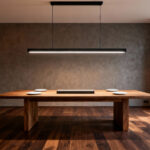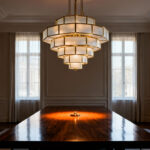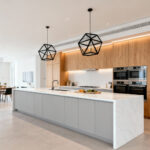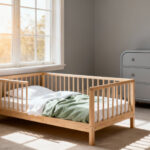Let’s be honest, the laundry room is often the forgotten stepchild of home design. It’s the place where lonely socks go to contemplate their existence, a chore-filled corner we cram into a basement or a hallway closet. We spend hours designing our kitchens and living rooms to be welcoming and beautiful, but the laundry space? It usually gets the leftovers.
But here’s the thing I’ve learned after more than a decade of designing homes that work for everybody: a thoughtfully designed laundry room can be revolutionary. It’s not just about making it pretty. It’s about making it work, really work, for your five-year-old who wants to “help,” for your dad who uses a walker, for you after a long day when your back is aching. Creating a space that makes a dreaded chore easier isn’t a luxury—it’s just good design.
1. Add Humorous or Inspirational Wall Art
A laundry room doesn’t have to feel like a sterile utility closet. Wall art is one of the quickest ways to inject some personality and make the space feel like an intentional part of your home. It breaks up the monotony of the machines and the endless piles.

I once worked with a family whose teenage son was in a wheelchair. We hung a large, vibrant pop-art print low on the wall, and beneath it, a smaller, funny sign that read, “I’m feeling a little washed out.” His mom told me later it was the first time he’d ever laughed while doing a chore. It’s a small thing, but it proves the point: humor and beauty belong everywhere. Mount pieces at different heights so they can be enjoyed from a standing or seated position.
A little bit of art gives the eye something to focus on besides the task at hand. It elevates the room instantly. Of course, a truly functional room needs more than just a pretty picture; it needs smart storage that’s within everyone’s reach.
2. Install Functional Floating Shelves
Floating shelves are a universal design powerhouse. They have a clean, modern look because they ditch the bulky brackets, but their real magic is in the placement. Unlike standard upper cabinets that are often too high for many people to reach comfortably, you can install floating shelves at any height you want.

When I’m planning a space, I always try to include at least one shelf at a lower, more accessible height—somewhere around 40-45 inches from the floor is a great target. This becomes the go-to spot for everyday essentials like detergent pods or stain remover. Higher shelves can then be used for backstock or less-frequently-used items. Pro tip: look for shelves with a small lip or add a slim rail to keep items from accidentally getting pushed off the edge. Safety first, always.
Once you have your shelves in place, the next step is to think about what you’re putting on them. The right containers can make all the difference.
3. Use Stylish Baskets and Bins for Storage
Good storage is the backbone of an organized laundry room. The right baskets and bins not only hide clutter but can also be a key accessibility feature. Frankly, flimsy plastic bins with tiny little grip indentations are a design failure. They’re hard to hold, they collapse, and they’re frustrating for anyone with limited hand strength.

Instead, look for containers that work for everyone. Think lightweight canvas bins with large, soft rope handles you can grab with a whole hand. Or smooth plastic containers with multiple grip options. I’m a big fan of using high-contrast colors for bins—say, dark gray bins on a white shelf—to make them easier to distinguish for someone with low vision. Clear fronts or good, bold labels are non-negotiable so everyone knows what’s what without having to pull down every single bin.
But even the most organized bins are hard to use if you can’t see what you’re doing. This is where the unsung hero of universal design steps in: good lighting.
4. Brighten the Room with Updated Lighting
I can’t stress this enough: great lighting is not a decoration, it’s a safety feature. It’s one of the most critical elements in any accessible space. In a laundry room, it means you can tell the difference between the navy socks and the black socks, spot a stain before it sets, and read the fine print on a care label. For someone with age-related vision changes, the right light can be the difference between independence and needing help.

You need layers of light. Start with a bright overhead (ambient) light, then add focused (task) lighting right over your folding counter and washer/dryer. I always recommend rocker switches instead of small toggles, as they’re easier to operate with an elbow or the side of your hand. Mount them lower, around 44-48 inches off the floor. And when you’re choosing bulbs, aim for a color temperature around 4000K. It’s a clean, neutral light that renders colors accurately without feeling harsh and clinical.
Good light makes everything in the room look better—including the wall color. So let’s make sure that color is doing its part, too.
5. Choose a Refreshing Paint Color or Wallpaper
Color can do some heavy lifting in a small space. Beyond just setting a mood, it can be a powerful tool for usability. Using a high-contrast color scheme isn’t about wild, clashing palettes; it’s about creating visual clarity.

Think about this: a white outlet plate on a pale beige wall can be tough for anyone to find in low light. But a white outlet on a deep blue or sage green wall? It pops. This same principle helps define different zones, making the room easier to navigate for someone with cognitive differences or vision loss. When choosing paint, a satin or semi-gloss finish is your best friend in a laundry room—it reflects light and is a breeze to wipe down. If you’re going with wallpaper, there are so many fantastic scrubbable options now that hold up beautifully to moisture.
Color sets the stage, but the most important functional surface in the entire room is the one where the real work of sorting, treating, and folding happens.
6. Upgrade or Add a Folding Countertop
A good, usable folding counter is probably the single most impactful feature in a universal laundry room. For years, the default was simply the top of the washing machine. Terrible. They’re often too high, too small, and have ridges that snag clothes. A dedicated countertop should serve people of all heights and abilities.

This is where it gets fun. You can have a counter at a standard height (36 inches) for standing, and another section at a lower height (around 30 inches) with open knee space underneath. This is absolutely essential for a wheelchair user to be able to roll right up and work comfortably. I designed a space for a client who, for the first time in years, could fold her family’s laundry herself, all because she finally had a workspace that fit her. We used a durable quartz with a matte finish to reduce glare, and a slightly rounded edge to prevent bumps and bruises.
That sturdy, practical surface is your workhorse. Now, you can bring in some softer, more natural elements to balance it out.
7. Introduce Greenery with Plants
Don’t underestimate the power of a plant! Bringing a little bit of green into your laundry room does more than just look nice. Plants can actually improve air quality, and their presence can make doing a chore feel a little less… well, like a chore. It introduces a sensory element—the look of the leaves, the earthy smell of the soil.

Choose plants that are famously hard to kill. Snake plants, ZZ plants, and pothos are fantastic, low-maintenance options that thrive in lower light and can handle a bit of humidity. And here’s a thought: place them at different heights. A trailing pothos on a high shelf adds drama, while a small succulent on the countertop can be enjoyed up close. Just be sure they’re non-toxic if you have curious pets or kids, and position them so they don’t become an obstacle.
The living element of a plant adds softness, and you can add physical softness and safety right under your feet.
8. Lay Down a Comfortable and Stylish Rug
A rug in the laundry room? Absolutely. Standing on a hard tile or vinyl floor for a long time is tiring for anyone. A good rug provides cushioning and comfort, but in universal design, it also plays a critical safety role.

This part’s important: you need a low-pile rug (less than ½ inch thick) with a non-slip backing. Tripping hazards are the enemy of accessible design. The edges must lay flat. A washable rug is a no-brainer here. Functionally, a rug can also provide a strong color contrast with the floor, which helps people with low vision identify the boundaries of the main standing area. Avoid super busy, high-contrast patterns that can create a dizzying effect, sometimes called visual vibration.
A rug helps define the floor space, just as smart wall storage can help define the vertical space in your room.
9. Install Creative Wall Hooks or Drying Racks
When floor space is at a premium, you have to go vertical. Wall-mounted hooks and drying racks are brilliant, space-saving solutions that turn empty walls into a functional part of your laundry system.

Forget one lonely row of hooks. Install them at multiple heights! A lower set (around 36 inches) is perfect for kids to hang up their own stuff or for someone in a wheelchair to reach. A standard-height row (around 48-54 inches) works for most adults. And I love the pull-down drying racks, like the ones from IKEA or Rev-A-Shelf. They fold up flat against the wall when you don’t need them but provide tons of drying space when you do, all without taking up a single square inch of floor.
Integrating these pieces into your design by choosing finishes that match your cabinet hardware helps them feel less like an afterthought and more like a deliberate, stylish choice.
10. Organize Supplies with Pretty Labels
Okay, I know. Labels might sound a little bit nerdy. But a good labeling system is a communication powerhouse. It’s not just for people who are hyper-organized; it’s a tool for independence. Clear, easy-to-read labels help kids learn the laundry process, support people with memory challenges, and ensure a house guest can run a load of laundry without having to ask a million questions.

The key to a truly universal label is using multiple cues. Use big, bold, sans-serif fonts. Add a simple picture or icon next to the text. Use high-contrast colors (like black text on a white label). This layered approach ensures the information can be understood by people with varying levels of vision and literacy. This tiny detail can make a huge impact on someone’s confidence in the space.
Your labeling system brings order to your supplies, but even more control comes from managing the natural light with the right window treatments.
11. Select Chic Window Treatments
If you’re lucky enough to have a window in your laundry room, the right treatment can be a game-changer for both light control and privacy. The big thing to look for here is ease of use. Those tiny cords on old-school blinds are a nightmare for anyone with arthritis or limited dexterity.

Cordless is the way to go. You can find beautiful options that you just push up or pull down with a light touch. Even better are motorized shades that operate with a remote or a smartphone app—they are a fantastic solution for a window located behind a washer and dryer where it’s hard to reach. Just make sure any control switches or buttons are placed in an accessible location, between 15-48 inches from the floor.
It’s a perfect example of universal design: a feature that is essential for some (like someone with limited mobility) is a wonderful convenience for everyone.
12. Include a Seating Area (If Space Allows)
If you have the space, even a small stool or bench can completely transform the functionality of your laundry room. So many parts of the laundry process—pretreating stains, sorting socks, folding—can be done while sitting down. For an older adult, a person with a disability, or even a pregnant parent, having a place to sit can be the difference between getting the chore done and not.

The ideal seat is sturdy, at a standard chair height (17-19 inches), and if possible, has armrests for extra support when sitting down or standing up. You need to make sure there’s enough clear floor space (a 30×48 inch rectangle is the gold standard) for someone in a wheelchair to approach it. A simple, stylish storage bench can be a perfect two-for-one solution: seating and a place to store extra supplies.
Even the products we use every day can be redesigned for better access, without sacrificing an ounce of style.
13. Decant Detergents into Decorative Containers
Those giant, heavy plastic jugs of liquid detergent are terribly designed. They’re unwieldy to lift, hard to pour without spilling, and the measurement caps are often impossible to read. One of my favorite—and prettiest—hacks is to decant supplies into better containers.

Transfer liquid detergent or softener into a clear glass beverage dispenser with a spigot. No heavy lifting, no messy pouring—just press the lever. For powders or pods, use wide-mouthed, lightweight canisters with easy-to-grip lids and a scoop. This isn’t just about making the shelf look like something from a magazine. It’s a real, practical solution that helps people with limited strength or dexterity handle the products independently and safely.
The little details matter so much, which brings me to the touchpoints you interact with every single time you open a door or drawer.
14. Update Cabinet Hardware for a Fresh Look
Cabinet hardware is the handshake of your cabinetry. It’s a tiny detail that can make a space feel updated, but it’s also a crucial point of interaction. Knobs that are small or slick can be incredibly difficult to grip for someone with arthritis or limited hand strength.

This is an easy and inexpensive upgrade with a big universal design payoff. Swap out small knobs for larger D-shaped or T-bar pulls. They allow you to open a cabinet with your whole hand, or even just a couple of fingers, instead of requiring a tight pinching grip. Choosing a finish that contrasts with your cabinet color (like matte black pulls on white cabinets) also makes them much easier to see. It’s a perfect marriage of style and function.
Some of the most clever solutions are the ones designed to solve those little, everyday annoyances we all experience.
15. Add a Functional Lint Bin or Lost Sock Container
Every laundry room has them: the little pile of lint next to the dryer and the sad, lonely collection of single socks. Giving these items a dedicated, intentional home brings order to the chaos and can add a touch of personality.

I love the magnetic lint bins that stick right to the side of your dryer. It keeps the bin off the floor and counter, and puts it exactly where you need it, when you need it. For lost socks, a simple, clearly labeled basket or a cute wall-mounted bag with a “Seeking Sole Mate” sign creates a system. It turns a point of frustration into a functional—and even charming—part of your room’s decor.
If you’re feeling a bit more ambitious, you can bring that same sense of personality and function all the way down to the floor.
16. Create a DIY Element Like a Stenciled Floor
If you have a dated but solid floor, you don’t always have to rip it out. A stenciled floor is a fantastic DIY project that lets you add a huge dose of personality. But it can also be a universal design tool.

When you’re choosing your paint, make sure to get a formula specifically designed for floors that includes a non-slip additive. This is non-negotiable for a space that can get wet. From a design perspective, you can use a pattern to create a visual “path” or to clearly define the work zone from the walkway. Just be mindful to choose patterns that aren’t overly busy, as they can sometimes create a disorienting effect. It’s a budget-friendly way to make a massive impact.
One final trick for making a small, often windowless, room feel bigger and brighter is a classic for a reason.
17. Incorporate a Mirror to Enhance Light
A mirror is a designer’s secret weapon in a small room. It bounces light around, making the entire space feel brighter and more open. But in a laundry room, it has practical applications, too.

Hanging a mirror lets you check for a missed spot on the back of your shirt. And if you hang a full-length mirror, it can be used by everyone in the house, whether they’re standing tall or seated. Position it so it doesn’t create a direct glare from a light fixture, and choose a frame that coordinates with your other finishes to make it feel like a seamless part of the decor.
Pulling all of these individual ideas together is what creates a space that truly works.
18. Define a Specific Design Theme (Farmhouse, Modern, etc.)
Having a clear design theme—whether it’s cozy farmhouse, sleek modern, or colorful boho—isn’t just about aesthetics. It creates a cohesive visual language for the room. This kind of consistency helps reduce “visual clutter,” making it easier for our brains to process the space, which is especially helpful for people with cognitive processing differences.

A theme acts as your guide. When you know you’re going for a modern look, it’s easier to choose a simple bar pull for the cabinets, a clean-lined faucet, and a minimalist light fixture. A theme helps tie all your universal design choices together into a space that feels harmonious and intentional, not like a random collection of accessible gadgets.
The final piece of the puzzle isn’t about fixtures or finishes; it’s about communication.
19. Hang a Chalkboard or Whiteboard for Notes
In a multi-generational or busy household, communication is everything. A simple chalkboard or whiteboard is a low-tech, high-impact tool. It’s a central spot to leave notes about what can and can’t go in the dryer, to remind someone about a stained shirt that needs special treatment, or to keep a running list of needed supplies.

Mount it at a height where both standing and seated family members can reach it. Keep chalk or markers in a container right next to it. For households with members who have limited hand dexterity, you can even create magnetic-backed, pre-printed instruction cards for common tasks. It supports memory, creates routine, and empowers everyone to participate in the household chores successfully.
Creating a Laundry Room That Cares for You
Rethinking your laundry room is about so much more than keeping up with the latest trends. It’s about designing a space with compassion and foresight. It’s about recognizing that a home should support us through all of life’s stages—from wrangling toddler clothes to aging in place with grace and independence.
By folding these ideas into your space, you’re not just creating a beautiful room. You’re creating a more functional, more inclusive, and kinder home. And here’s the wonderful secret of universal design: when you design for everyone, you inevitably create a space that works better for you, too. And that’s not magic—that’s just smart, thoughtful design.






